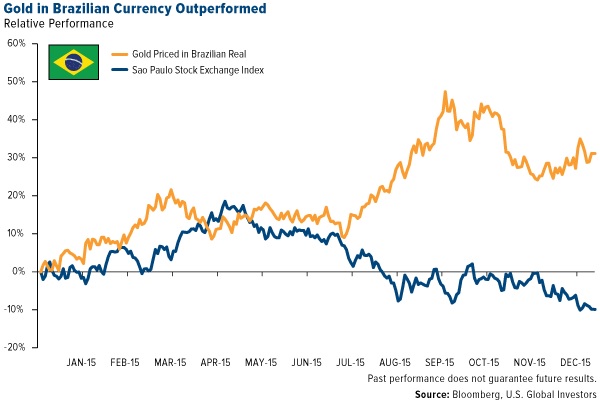Year-End Precious Metals Overview
Strengths
- The best-performing precious metals as we close out 2015 were gold and silver with returns of minus 10.47 percent and minus 12.45 percent, respectively. The NYSE Arca Gold Miners Index was down 24.51 percent for the year.
- Klondex Mines, one of the few gold stocks to deliver positive returns each of the last three years, finished the year up 21.90 percent in U.S. dollar terms. A star performer over the last two years has been Northern Star, which was up 70.54 percent just over the trailing year. Another turnaround this year was led by Bob Vassie, the new CEO of St. Barbara Ltd., for a 1,111.70 percent gain. These kinds of outcomes don’t come randomly. The management teams at Klondex, led by CEO Paul Huet, CEO Bill Beament at Northern Star, and Bob Vassie at St. Barbara all have the expertise and skillset needed to execute for shareholders and to deliver positive outcomes.
- India’s silver import is set to post a new record this year, according to Business Insider. Total silver import for calendar year 2015 is estimated at 7,759 tonnes (on an annualized basis), which registers a rise of around 10 percent from 2014.
Weaknesses
- The worst-performing precious metals for 2015 were platinum and palladium with returns of minus 26.07 percent and minus 29.43 percent, respectively. The platinum mining stocks in Southern Africa were off on average by more than 70 percent for the year.
- The worst-performing gold mining stocks in larger capitalization names were Cia de Minas Buenaventura S.A.A. minus 55.23 percent, Yamana Gold minus 45.20 percent, Alamos Gold minus 45.18 percent, and Eldorado Gold minus 42.09 percent.
- The Bloomberg Commodity Spot Index has witnessed its worst performance since 2008, dropping 19 percent this year. A significant reason for the disappointing performance in commodities, reports Bloomberg, has been the strong U.S. dollar which is up 9.40 percent for 2015 against a group of other global currencies. Many of the gold stocks are now trading below the levels they plummeted to in 2008.
Opportunities
- Some big names still have big holdings in gold. The Moltly Fool points out that John Paulson and his hedge fund group Paulson & Co. own about $900 million worth of shares of the SPDR Gold Trust. Another investor showing confidence in gold is Ray Dalio, founder of Bridgewater Associates, who has said, “If you don’t own gold, you know neither history nor economics.” Paulson and Dalio seem to be demonstrating gold’s use as a hedge against uncertainty in fragile markets.
- Gold has been falling hard since 2013, being pulled down right alongside the rest of the commodities complex. However, as John Rubino points out in a Seeking Alpha article, this is only in U.S. dollar terms. As seen in the chart below, gold is behaving just fine in Canadian dollar terms, up 7 percent over the past year and which helped offset the negative returns of Canadian stock market which fell 11 percent. Rubino writes, “Protection from currency trouble is why people own it (gold), and why in the vast majority of places its owners are very happy.”

- The same holds true for many other weak domestic currencies. Gold priced in Brazilian real surged 31 percent while the Brazil’s top 100 stocks lost 10 percent as shown in the chart below. While the U.S. dollar strengthened with the much-hyped Fed hike in interest rates, history shows that the dollar typically does not get stronger after the first rate hike, so for U.S. investors, now could be an opportune time to rebalance your portfolio of assets.

Threats
- Gold bears are claiming that the major banks haven’t been buying gold. Zero Hedge reports that Goldman Sachs expects the price of gold to fall to $1,000 per ounce, while others, including BNP Paribas and ABN Amro expect gold to fall even lower. Zero Hedge points out that when popular sentiment has shifted away from gold.
- According to a Bloomberg report, the U.S. dollar is headed for its biggest monthly loss since August (against the yen) and since April (versus the euro) following the Federal Reserve’s decision to hike interest rates for the first time since 2006. At the same time, the Surprise Index which is a Citigroup measurement of how U.S. economic indicators compare with forecasts, heads for a second monthly decline.
- A group of 10 Wall Street strategists announced their forecasts for 2016, as published on Zero Hedge this week. Five strategists say to avoid materials, four strategists warn against energy, while nearly all were bullish on financials and technology. The forecasts, originally sourced in Barron’s, were brought to light during a Bloomberg TV interview with Marc Faber earlier in the week. Faber stated that the U.S. is headed into recession and rather than be bullish on U.S. equities (as a majority of the strategists were), to instead “be realistic.”






 Frank Holmes is the CEO and Chief Investment Officer of
Frank Holmes is the CEO and Chief Investment Officer of 








